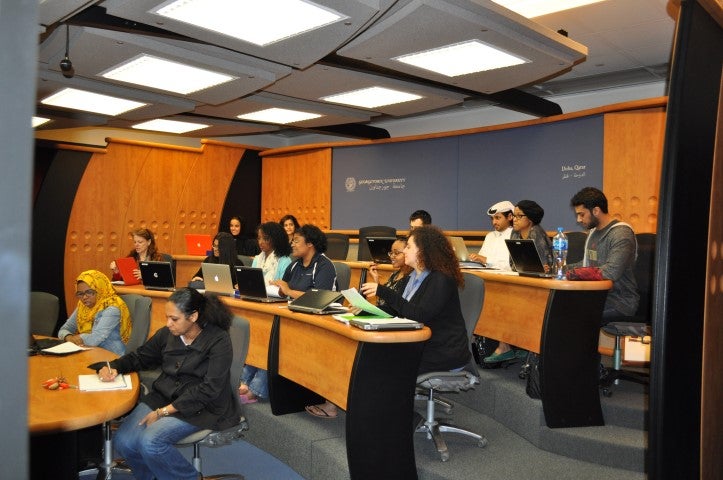Georgetown Students in Qatar and Washington Use New High-Tech Platform for Research Collaboration

Anthropologist Rogaia Mustafa Abusharaf, Associate Professor at SFS-Q, brought bi-local accessibility and student collaboration to a new level this academic year with the introduction and use of a new tool that advanced the efficacy of the RPX classroom.
This year Abusharaf’s International Affairs course, Horn of Africa: Culture and Politics, was taught in the RPX Global classroom. What made this RPX experience different for the students who were 8,000 miles apart—in Washington, D.C., and Doha, Qatar—was the introduction and use of Omeka to present collaborative projects.
Omeka describes itself as a flexible and open source web-publishing platform for the display of library, museum, archives, and scholarly collections and exhibitions. Abusharaf’s students used the new platform to collaborate on the course’s research projects, which allowed for their hard work to be viewable and accessible online even after the class finished for the term.
Virginia Jones, Instructional Design Analyst at SFS-Q, explained: “Omeka is designed for use by non-IT specialists. It brings Web 2.0 technologies to academic environments and is brilliant because its easy-to-use template design encourages students to interact and participate fully and frequently. The final product is the online publication of scholarly research, exhibited in an international standards-based, professional portfolio, accessible and available to all.”
Abusharaf is an anthropologist and accomplished scholar whose research focuses on political and cultural anthropology, human rights, migration and diaspora studies, and diversity in international perspectives. Her Horn of Africa class focuses on the ethnography and political study of the intersecting themes of cultural production, political participation, and civic protest in the Horn of Africa region. It is a challenging course that uses comparative and interdisciplinary methodologies to analyze the context in which the region’s history is made.
“I had the students read works on the various countries of the sub-region,” said Abusharaf. “They analyzed contesting histories and complementary methodologies. This work culminated with the students preparing their own digital presentations of some of these themes. This was the first time we had used a technology such as Omeka for presentations, and I was very pleased with its ease of use and the collaboration it fostered among the students, especially with the students being physically so distant yet virtually so close.”
Sarah Mohamed (SFS-Q’14) was in the Horn of Africa class and said that Omeka was helpful because it provided a platform to pursue research in a more tangible, robust, and inclusive way then that followed when writing a research paper. She said, “When writing a paper you usually resort to articles and books for sources and focus narrowly on a specific element of the argument but with this approach we looked at our topics more holistically and from different angles using a collection of sources.” Those additional sources included documentaries, paintings, photographs, interviews, and much more.
Horn of Africa: Culture and Politics was team-taught in the RPX Georgetown classrooms by Professor Abusharaf in Doha, Qatar, and Assistant Professor Lahra Smith, in Washington, D.C.